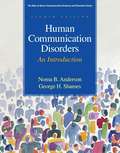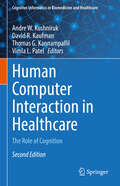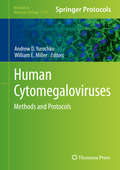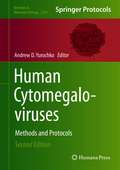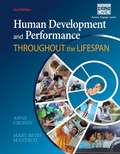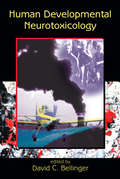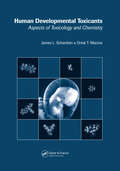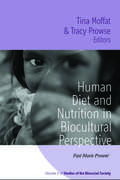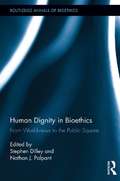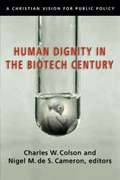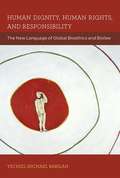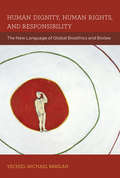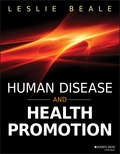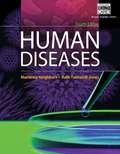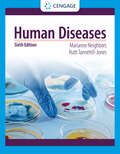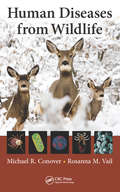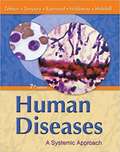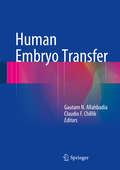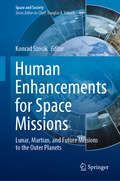- Table View
- List View
Human Communication Disorders: An Introduction (Eighth Edition)
by Noma B. Anderson George H. ShamesThis leading introductory book on communication disorders uses student-friendly content to explore current research, central theories, and the nuts and bolts of clinical therapy. Updated with the most current research and information, the newly revised eighth edition of Human Communication Disorders continues to cover a broad range of topics including speech and language development, genetics, the biology and physics of communication, and an overview of cultural and linguistic diversity. With an emphasis on evidence-based practice, experts in speech-language pathology and audiology place communication processes and communication disorders in perspective, define basic theories of causation, introduce identifying characteristics, and present an overview of procedures for evaluation and treatment - while at the same time focusing on the real people who both have communication disorders and the real people who study them. The new eighth edition has been rewritten with a more contemporary, student-friendly approach and style that makes the content more engaging and easier to process.
Human Computer Interaction in Healthcare: The Role of Cognition (Cognitive Informatics in Biomedicine and Healthcare)
by Vimla L. Patel Thomas G. Kannampallil David R. Kaufman Andre W. KushnirukThis thoroughly updated edition reports on the current state of human computer interaction (HCI) in biomedicine and healthcare, focusing on the cognitive underpinnings of human interactions with people and technology. With health information technologies becoming increasingly vital tools for the practice of clinical medicine, this book draws from key theories, models and evaluation frameworks, and their application in biomedical contexts to apply this to current research in HCI. However, numerous challenges remain in order to fully realize their potential as instruments for advancing clinical care and enhancing patient safety. There is a general consensus that health IT has not realized its potential as a tool to facilitate clinical decision-making, the coordination of care and improvements in patient safety. Embracing sound principles of iterative design can yield significant dividends. It can also enhance practitioner’s abilities to meet “meaningful use” requirements. The purpose of the book is two-fold: to address key gaps on the applicability of theories, models and evaluation frameworks of HCI and human factors for research in biomedical informatics. It highlights the state of the art, drawing from the current research in HCI. It also serves as a graduate level textbook highlighting key topics in HCI relevant for biomedical informatics, computer science and social science students working in the healthcare domain. Cognitive Informatics for Biomedicine: Human Computer Interaction in Healthcare is indispensable to those who want to ensure that the systems they build, and the interactive environments that they promote, will reflect the rigor and dedication to human-computer interaction principles that will ultimately enhance both the user’s experience and the quality and safety of the care that is offered to patients. It is an essential reference to all who are interested in the application of these new techniques within healthcare, from students of informatics through to clinicians, informatics researchers and developers of health IT looking to incorporate them into their day-to-day workflow.
Human Cytomegaloviruses
by Andrew D. Yurochko William E. MillerWith the significant medical role that human cytomegalovirus plays in human disease (from acute disease following primary infection, to chronic disease due to life-long viral persistence), the need to better understand human cytomegalovirus biology and pathogenesis is needed. "Human Cytomegaloviruses: Methods and Protocols "is designed to be an inclusive document covering all of the techniques and approaches necessary to understand and study the pathobiology of human cytomegalovirus. Topics covered include the history of human cytomegaloviruses, techniques to culture and grow the virus in model cell types, the use of primary cells for the study of human cytomegalovirus pathogenesis, modern molecular techniques for assessing the biological consequences of viral infection, animal models for study of cytomegalovirus replication and numerous other topics of current interest. Written in the successful "Methods in Molecular Biology" series format, each chapter includes an introduction, list of necessary materials and reagents, step-by-step, readily reproducible protocols, and notes on troubleshooting and avoiding known pitfalls. Authoritative and easily accessible, "Human Cytomegaloviruses: Methods and Protocols "serves as a tool for basic scientists as well as clinical scientists with an interest in the basic fundamental aspects of viral gene expression and specific aspects of viral pathogenesis. "
Human Cytomegaloviruses: Methods and Protocols (Methods in Molecular Biology #2244)
by Andrew D. YurochkoThis new edition explores and provides an update on the biology and pathogenesis of human cytomegalovirus infection. Modern techniques that are currently being utilized to investigate the molecular aspects of viral infection, as well as how these new research studies are leading to new approaches to mitigate disease, are also provided. Given the key role the virus plays in significant acute and chronic human disease in all stages of life, from newborns to seniors, the need for clear methodologies to further explore the biology of HCMV infection and mitigation strategies is readily apparent. Written in the highly successful Methods in Molecular Biology format, chapters include introductions to their respective topics, lists of the necessary materials and reagents, step-by-step, readily reproducible laboratory protocols, and tips on troubleshooting and avoiding known pitfalls. Authoritative and up-to-date, Human Cytomegaloviruses: Methods and Protocols, Second Edition serves as an ideal scientific reference for basic and clinical scientists and medical personnel on the modern understanding of the pathobiology of the virus, and the approaches, techniques, and models to study human cytomegalovirus infection and disease.
Human Development and Performance Throughout the Lifespan
by Anne Cronin Mary Beth MandichHuman Development & Performance Throughout the Lifespan, 2nd Edition is ideal for occupational therapy, physical therapy, and other rehabilitation disciplines. It provides a broad, occupation-based viewpoint of development and performance throughout all life stages with an emphasis on the factors that influence daily participation and optimal performance of desired daily life tasks. The authors use a life course conceptual model as an organizational foundation for clinical reasoning to help readers understand how to implement the activity- and participation-based goals and outcomes for therapy. Written by an occupational therapist and a physical therapist, the book incorporates chapters by leading experts in human development, giving users cutting-edge information and a wide range of perspectives. By integrating information from the International Classification of Function and Disability (ICF) with a developmental life-task perspective, the book gives both newcomers and experienced professionals an essential, contemporary frame of reference.
Human Developmental Neurotoxicology
by Nasimul AhsanThis reference describes the most recent developments in the design, execution, and interpretation of human developmental neurotoxicology studies. Assessing critical issues and controversies in the field, this guide focuses on dose-response/effect relationships and explores challenges in the measurement of exposure to different types of chemicals,
Human Developmental Toxicants: Aspects of Toxicology and Chemistry
by James L. Schardein Orest T. MacinaPresenting the first database of its kind, this unique reference illustrates the relationships between the chemistry and developmental toxicity of a number of important pharmaceuticals and industrial toxicants. Human Developmental Toxicants contains up-to-date and concise information on the chemical structures, properties, and biological activities
Human Diet And Nutrition In Biocultural Perspective
by Tina Moffat Tracy ProwseThere are not many areas that are more rooted in both the biological and social-cultural aspects of humankind than diet and nutrition. Throughout human history nutrition has been shaped by political, economic, and cultural forces, and in turn, access to food and nutrition has altered the course and direction of human societies. Using a biocultural approach, the contributors to this volume investigate the ways in which food is both an essential resource fundamental to human health and an expression of human culture and society. The chapters deal with aspects of diet and human nutrition through space and time and span prehistoric, historic, and contemporary societies spread over various geographical regions, including Europe, North America, Africa, and Asia to highlight how biology and culture are inextricably linked.
Human Dignity in Bioethics: From Worldviews to the Public Square (Routledge Annals of Bioethics)
by Stephen Dilley Nathan J. PalpantHuman Dignity in Bioethics brings together a collection of essays that rigorously examine the concept of human dignity from its metaphysical foundations to its polemical deployment in bioethical controversies. The volume falls into three parts, beginning with meta-level perspectives and moving to concrete applications. Part 1 analyzes human dignity through a worldview lens, exploring the source and meaning of human dignity from naturalist, postmodernist, Protestant, and Catholic vantages, respectively, letting each side explain and defend its own conception. Part 2 moves from metaphysical moorings to key areas of macro-level influence: international politics, American law, and biological science. These chapters examine the legitimacy of the concept of dignity in documents by international political bodies, the role of dignity in American jurisprudence, and the implications—and challenges—for dignity posed by Darwinism. Part 3 shifts from macro-level topics to concrete applications by examining the rhetoric of human dignity in specific controversies: embryonic stem cell research, abortion, human-animal chimeras, euthanasia and palliative care, psychotropic drugs, and assisted reproductive technologies. Each chapter analyzes the rhetorical use of ‘human dignity’ by opposing camps, assessing the utility of the concept and whether a different concept or approach can be a more productive means of framing or guiding the debate.
Human Dignity in the Biotech Century: A Christian Vision for Public Policy
by Nigel M. de S. Cameron Charles W. ColsonWhat will be the greatest moral challenge facing our society throughout this century?Are we ready to face it?Editors Charles W. Colson and Nigel M. de S. Cameron, along with a panel of expert contributors, make the case in this book that the greatest watershed debates of the twenty-first century concerning ethics and public policy will surround the issue of biotechnology. In twelve essays they address several of the legal and ethical challenges before us: embryo research, stem cell research, cloning, genetic engineering, gene therapy, pharmacogenomics, cybernetics, nanotechnology and, of course, abortion. Contributors includeWilliam L. Saunders, J. D. , Family Research CouncilChristopher Hook, M. D. , The Mayo ClinicHenk Jochemsen, Ph. D. , Free University of AmsterdamDavid A. Prentice, Ph. D. , Indiana State UniversityNathan A. Adams IV, Ph. D. , J. D. , Christian Legal SocietyDavid Stevens, M. D. , Christian Medical AssociationPaige Comstock Cunningham, J. D. , Americans United for LifeC. Ben Mitchell, Ph. D. , Trinity Evangelical Divinity SchoolRichard Doerflinger, M. A. , Secretariat for Pro-life, National Conference of Catholic BishopsWesley J. Smith, J. D. , International Task Force on Euthanasia and Assistend SuicideLeaders in their fields, these contributors point out the crucial role Christians can and should play in the public square. The well-informed and forward-looking perspectives they present will help us prepare for the challenges ahead.
Human Dignity, Human Rights, and Responsibility
by Yechiel Michael Barilan"Human dignity" has been enshrined in international agreements and national constitutions as a fundamental human right. The World Medical Association calls on physicians to respect human dignity and to discharge their duties with dignity. And yet human dignity is a term--like love, hope, and justice--that is intuitively grasped but never clearly defined. Some ethicists and bioethicists dismiss it; other thinkers point to its use in the service of particular ideologies. In this book, Michael Barilan offers an urgently needed, nonideological, and thorough conceptual clarification of human dignity and human rights, relating these ideas to current issues in ethics, law, and bioethics. Combining social history, history of ideas, moral theology, applied ethics, and political theory, Barilan tells the story of human dignity as a background moral ethos to human rights. After setting the problem in its scholarly context, he offers a hermeneutics of the formative texts on Imago Dei; provides a philosophical explication of the value of human dignity and of vulnerability; presents a comprehensive theory of human rights from a natural, humanist perspective; explores issues of moral status; and examines the value of responsibility as a link between virtue ethics and human dignity and rights. Barilan accompanies his theoretical claim with numerous practical illustrations, linking his theory to such issues in bioethics as end-of-life care, cloning, abortion, torture, treatment of the mentally incapacitated, the right to health care, the human organ market, disability and notions of difference, and privacy, highlighting many relevant legal aspects in constitutional and humanitarian law.
Human Dignity, Human Rights, and Responsibility: The New Language of Global Bioethics and Biolaw (Basic Bioethics)
by Yechiel Michael BarilanA novel and multidisciplinary exposition and theorization of human dignity and rights, brought to bear on current issues in bioethics and biolaw.“Human dignity” has been enshrined in international agreements and national constitutions as a fundamental human right. The World Medical Association calls on physicians to respect human dignity and to discharge their duties with dignity. And yet human dignity is a term—like love, hope, and justice—that is intuitively grasped but never clearly defined. Some ethicists and bioethicists dismiss it; other thinkers point to its use in the service of particular ideologies. In this book, Michael Barilan offers an urgently needed, nonideological, and thorough conceptual clarification of human dignity and human rights, relating these ideas to current issues in ethics, law, and bioethics.Combining social history, history of ideas, moral theology, applied ethics, and political theory, Barilan tells the story of human dignity as a background moral ethos to human rights. After setting the problem in its scholarly context, he offers a hermeneutics of the formative texts on Imago Dei; provides a philosophical explication of the value of human dignity and of vulnerability; presents a comprehensive theory of human rights from a natural, humanist perspective; explores issues of moral status; and examines the value of responsibility as a link between virtue ethics and human dignity and rights.Barilan accompanies his theoretical claim with numerous practical illustrations, linking his theory to such issues in bioethics as end-of-life care, cloning, abortion, torture, treatment of the mentally incapacitated, the right to health care, the human organ market, disability and notions of difference, and privacy, highlighting many relevant legal aspects in constitutional and humanitarian law.
Human Disease and Health Promotion
by Leslie BealeThe essential tools and methodologies for real-world patient education Human Disease and Health Promotion offers a comprehensive introduction to health advocacy and patient education in a real-world context. Covering the epidemiology and pathology of major communicable and non-communicable diseases, this book details up-to-date health promotion strategies and communication approaches designed to engage diverse populations. These methodologies can inform health promotion efforts. You'll learn how to partner with the patient to navigate healthcare systems and services and how to manage the relationship to avoid patient dependence and advocate burn-out. An extensive guide to common diseases includes details on mechanism, treatment, epidemiology, pathology, and attendant psychosocial implications, and prevention and control are emphasized to the degree that the patient has the capacity to obtain, process, and understand the information and services needed to make appropriate health decisions. Rich in examples, tools, and exercises, this text includes access to a downloadable workbook that provides additional exercises to reinforce concepts and build essential practical skills. Public health education and advocacy is an enormous undertaking with many variables. This book helps provides a real-world picture of the depth and breadth of the field, with clear guidance toward current theory and practice. Apply current health literacy theories and participatory patient education strategies Design, implement, and evaluate programs targeting various groups Analyze and apply new technologies in patient education and health advocacy Understand the mechanisms, treatments, and epidemiology of common diseases Nine out of ten adults may lack the skills needed to manage their health and prevent disease, and over half find it a challenge to self-manage chronic diseases and use health services appropriately. Human Disease and Health Promotion helps you develop your role as health educator and advocate so you can connect patients with the care and information they need.
Human Diseases (Mindtap Course List)
by Marianne Neighbors Ruth Tannehill-JonesDesigned specifically for allied health students, HUMAN DISEASES, Sixth Edition, delivers comprehensive coverage packed with the latest research and developments from real-world practice. Extremely reader friendly, this best-selling pathophysiology text begins with a basic review of anatomy and physiology, then explores the diseases and disorders health care professionals see and treat most often. <P><P>Intuitively organized chapters present each disease's description, etiology, symptoms, diagnosis, treatment and prevention, while detailed, full-color photos help readers gain a thorough understanding of key concepts. Completely up to date, the Sixth Edition includes information on new and emerging disorders, ICD-10 progress, pharmacology concerns, herbal and nontraditional remedies, current statistics and more. Its thought-provoking vignettes, real-life cases and interactive learning tools make pathology more accessible than ever for today's learners.
Human Diseases from Wildlife
by Michael R. Conover Rosanna M. VailHuman Diseases from Wildlife presents information on the most prevalent and serious zoonotic diseases in the US and Canada, some of which have been national headline news like anthrax, influenza, and West Nile virus. Diseases that are caused by pathogens with the ability to infect both humans and animals are known as zoonotic diseases, which litera
Human Diseases: A Systemic Approach
by Mark Zelman Mary Lou Mulvihill Elaine Tompary Jill Raymond Paul HoldawayThis book presents the basic principles of human disease, organized by human organ system. It provides practical information for both health career and non-professional readers—unlike other books, which are generally too high level or specialized for this purpose. <P><P> New to this edition are: new diagnostic tests and lab procedures; enhanced coverage in treatment and diagnostic sections in disorders to include common treatments and general pharm options; increased coverage of disease statistics, prevalencies, risk factors for diseases and conditions; addition of prevention and aging to Diseases at a Glance table at the end of each chapter; A new page will be added at the end of each chapter which walks the readers through the multimedia resources that are available for each chapter; and much more!
Human Embryo Transfer
by Gautam N. Allahbadia Claudio F. ChillikThis concise work on embryo transfer is yet another contribution to the persevering effort to disseminate latest information on the science and skill of performing a traumatic and successful embryo transfer. It is the most critical culmination of the assisted reproductive technology (ART) stimulation cycle, and a rate-limiting step in dictating the success of treatment. The well-worded chapters draw the reader's attention to significant aspects before initiating the actual embryo transfer, such as possible causes of failure at the embryo transfer stage, uterine evaluation, mock embryo transfer (ET), experience of the physician, and the use of ultrasound-guidance to monitor ET. The protocol for difficult transfers, variables that affect the success of ET, and the influence of the catheter used for ET have also been dealt with. The unique feature of this book is its pragmatic approach that can translate into solutions to the numerous frustrating ART failures that more often than not, may be attributed to an inefficient ET procedure. It helps the reader understand the integrity of embryo transfer, unravel its obvious simplicity and bridge the success between the several steps of ART. By highlighting the impeding problems associated with ET procedure and providing valid, scientific solutions, this stimulating edition will help the readers improve the ART success rates in their clinical practice.
Human Enhancements for Space Missions: Lunar, Martian, and Future Missions to the Outer Planets (Space and Society)
by Konrad SzocikThis book presents a collection of chapters, which address various contexts and challenges of the idea of human enhancement for the purposes of human space missions. The authors discuss pros and cons of mostly biological enhancement of human astronauts operating in hostile space environments, but also ethical and theological aspects are addressed. In contrast to the idea and program of human enhancement on Earth, human enhancement in space is considered a serious and necessary option. This book aims at scholars in the following fields: ethics and philosophy, space policy, public policy, as well as biologists and psychologists.
Human Epigenetics: How Science Works
by Carsten Carlberg Ferdinand MolnárThe view “It’s all in our genes and we cannot change it” developed in the past 150 years since Gregor Mendel’s experiments with flowering pea plants. However, there is a special form of genetics, referred to as epigenetics, which does not involve any change of our genes but regulates how and when they are used. In the cell nucleus our genes are packed into chromatin, which is a complex of histone proteins and genomic DNA, representing the molecular basis of epigenetics. Our environment and lifestyle decisions influence the epigenetics of our cells and organs, i.e. epigenetics changes dynamically throughout our whole life. Thus, we have the chance to change our epigenetics in a positive as well as negative way and present the onset of diseases, such a type 2 diabetes or cancer. This textbook provides a molecular explanation how our genome is connected with environmental signals. It outlines that epigenetic programming is a learning process that results in epigenetic memory in each of the cells of our body. The central importance of epigenetics during embryogenesis and cellular differentiation as well as in the process of aging and the risk for the development of cancer are discussed. Moreover, the role of the epigenome as a molecular storage of cellular events not only in the brain but also in metabolic organs and in the immune system is described. The book represents an updated but simplified version of our textbook “Human Epigenomics” (ISBN 978-981-10-7614-8). The first five chapters explain the molecular basis of epigenetics, while the following seven chapters provide examples for the impact of epigenetics in human health and disease.
Human Error in Medicine (Human Error and Safety)
by Marilyn Sue BognerThis edited collection of articles addresses aspects of medical care in which human error is associated with unanticipated adverse outcomes. For the purposes of this book, human error encompasses mismanagement of medical care due to: * inadequacies or ambiguity in the design of a medical device or institutional setting for the delivery of medical care; * inappropriate responses to antagonistic environmental conditions such as crowding and excessive clutter in institutional settings, extremes in weather, or lack of power and water in a home or field setting; * cognitive errors of omission and commission precipitated by inadequate information and/or situational factors -- stress, fatigue, excessive cognitive workload. The first to address the subject of human error in medicine, this book considers the topic from a problem oriented, systems perspective; that is, human error is considered not as the source of the problem, but as a flag indicating that a problem exists. The focus is on the identification of the factors within the system in which an error occurs that contribute to the problem of human error. As those factors are identified, efforts to alleviate them can be instituted and reduce the likelihood of error in medical care. Human error occurs in all aspects of human activity and can have particularly grave consequences when it occurs in medicine. Nearly everyone at some point in life will be the recipient of medical care and has the possibility of experiencing the consequences of medical error. The consideration of human error in medicine is important because of the number of people that are affected, the problems incurred by such error, and the societal impact of such problems. The cost of those consequences to the individuals involved in medical error, both in the health care providers' concern and the patients' emotional and physical pain, the cost of care to alleviate the consequences of the error, and the cost to society in dollars and in lost personal contributions, mandates consideration of ways to reduce the likelihood of human error in medicine. The chapters were written by leaders in a variety of fields, including psychology, medicine, engineering, cognitive science, human factors, gerontology, and nursing. Their experience was gained through actual hands-on provision of medical care and/or research into factors contributing to error in such care. Because of the experience of the chapter authors, their systematic consideration of the issues in this book affords the reader an insightful, applied approach to human error in medicine -- an approach fortified by academic discipline.
Human Errors: A Panorama of Our Glitches, From Pointless Bones to Broken Genes
by Nathan LentsWe like to think of ourselves as highly evolved. But if we are evolution's greatest creation, why are we so badly designed? We have retinas that face backward, we must find vitamins and nutrients in our diets that other animals simply make for themselves and millions of us can't reproduce successfully without help from modern science. And that's just the beginning of the story. Biologist Nathan H. Lents takes us on an entertaining and illuminating tour of our four-billion-year-long evolutionary saga, and shows us how each of our flaws tells us a story about our species' history.
Human Errors: A Panorama of Our Glitches, From Pointless Bones to Broken Genes
by Nathan LentsWe like to think of ourselves as highly evolved creatures. But if we are evolution's greatest creation, why are we so badly designed? We have retinas that face backward, the stump of a tail, and way too many bones in our wrists. We must find vitamins and nutrients in our diets that other animals simply make for themselves. Millions of us can't reproduce successfully without help from modern science. We have nerves that take bizarre paths, muscles that attach to nothing, and lymph nodes that do more harm than good. And that's just the beginning of the story.As biologist Nathan H. Lents explains, our evolutionary history is a litany of mistakes, each more entertaining and enlightening than the last. As we will discover, by exploring human shortcomings, we can peer into our past, because each of our flaws tells a story about our species' evolutionary history.A rollicking, deeply informative tour of our four-billion-year-long evolutionary saga, Human Errors both celebrates our imperfections - for our mutations are, in their own way, a testament to our species' greatness - and offers an unconventional accounting of the cost of our success.Read by L.J. Ganser(p) Tantor Media 2018
Human Evolutionary Genetics
by Mark Jobling Edward Hollox Toomas Kivisild Chris Tyler-SmithHuman Evolutionary Genetics is a groundbreaking text which for the first time brings together molecular genetics and genomics to the study of the origins and movements of human populations. Starting with an overview of molecular genomics for the non-specialist (which can be a useful review for those with a more genetic background), the book shows h
Human Experimentation and Research (The\international Library Of Medicine, Ethics And Law)
by David N. Weisstub George F. TomossyThis title was first published in 2003: As new medical technologies and treatments develop with increasing momentum, the legal and ethical implications of research involving human participants are being called into question as never before. Human Experimentation and Research explores the philosophical foundations of research ethics, ongoing regulatory dilemmas, and future challenges raised by the rapid globalisation and corporatisation of the research endeavour. This volume brings together some of the most significant published essays in the field. The editors also provide an informative introduction, summarizing the area and the relevance of the articles chosen.
